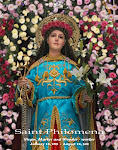 First of all, we take a look at the lectionary. In the ordinary form of the Roman rite, the Sunday readings are so arranged that the three mysteries of Epiphany are read for three consecutive Sundays. The now-transferable feast of the Epiphany is often celebrated today on the first Sunday of January (unless New Year's day falls on a Sunday). On Epiphany Sunday, the Gospel reading is about the Adoration of the Magi. The 2nd Sunday of January is kept as the Feast of the Baptism. In this Feast, the 2nd mystery of Epiphany is referred to in the readings. On the 3rd Sunday of January, the Gospel reading is always about the Wedding at Cana, which is the 3rd mystery of Epiphany. It is just unfortunate that the Feast of the Santo Nino in the Philippines takes precedence over the reading of the Wedding at Cana. If only the Feast of the Santo Nino were moved to the 4th Sunday of January, we will have the spirit of Christmas and Epiphany felt throughout the entire month of January. Of course, everything ends with the Feast of the Presentation of the Lord on February 2.
First of all, we take a look at the lectionary. In the ordinary form of the Roman rite, the Sunday readings are so arranged that the three mysteries of Epiphany are read for three consecutive Sundays. The now-transferable feast of the Epiphany is often celebrated today on the first Sunday of January (unless New Year's day falls on a Sunday). On Epiphany Sunday, the Gospel reading is about the Adoration of the Magi. The 2nd Sunday of January is kept as the Feast of the Baptism. In this Feast, the 2nd mystery of Epiphany is referred to in the readings. On the 3rd Sunday of January, the Gospel reading is always about the Wedding at Cana, which is the 3rd mystery of Epiphany. It is just unfortunate that the Feast of the Santo Nino in the Philippines takes precedence over the reading of the Wedding at Cana. If only the Feast of the Santo Nino were moved to the 4th Sunday of January, we will have the spirit of Christmas and Epiphany felt throughout the entire month of January. Of course, everything ends with the Feast of the Presentation of the Lord on February 2.This is even clearer in the arrangement of both feasts and readings in the Extraordinary Form of the Roman Rite. The first Sunday of January is always the Feast of the Holy Name of Jesus (unless the Octave of Christmas falls on a Sunday...in this case, the Holy Name is celebrated on January 2.) January 6 is always Epiphany in which the Reading would be about the Adoration of the Magi. The second Sunday of January is always the Feast of the Holy Family which commemorates the finding of the Child Jesus in the temple.
January 13 is always the Feast of the Baptism of the Lord, which is the 2nd mystery of Epiphany. The reading for the ferial Masses on the first week after Epiphany is always the same Finding of the Child Jesus in the Temple. The third Sunday of January will be the 2nd Sunday after Epiphany in which the reading will be about the Wedding at Cana, which is the 3rd Mystery of Epiphany. Again, if only the Feast of the Santo Nino were moved to the 4th Sunday of January...the Christmas season will obviously be extended throughout the month of January and will be concluded by the Feast of the Presentation of the Lord or the Purification of our Lady.










Hello Father..... you must see this Catholic "blog". It is not a blog but a collection of everything Catholic information. With over 1000 legally free ebooks, must see prophecies and much more.
ReplyDeletehttp://catholicguidance.blogspot.ca/